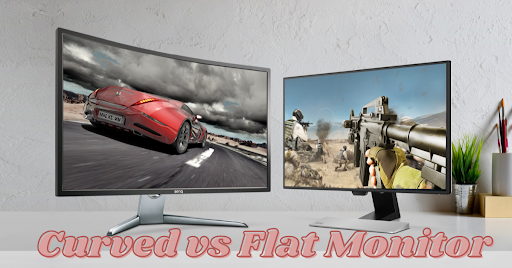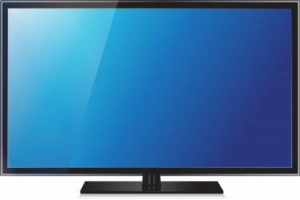Curved Vs Flat Monitor : Point To Point Comparison

One of the first technological accessories we consider while setting up a home or an office is a visual/audio display or a television. There are a number of points to be kept in mind while purchasing a new television. A monitor is always purchased keeping in mind the dimensions of the wall it will be mounted upon, the room where it will be kept and the aesthetics of the house, and the preference of the buyer. With the advent of technology, we have upgraded ourselves from box television to screens that can be put off the wall. There are two types of screens, the flat monitor and the curved monitor. This article will explore which curved vs flat monitor will be good for you.
Curved Monitors
An electronic display that has a concave viewing surface, as opposed to a flat-panel display, is called a curved screen. Curved screens are frequently promoted as having a broader field of view and the ability to deliver an “immersive” experience. The size of the visible observable world is defined by the field of vision (FoV).
A solid-angle optical device, such as this sort of screen, allows us to observe what is occurring inside the “computer world.” The field of view (FoV) of someone viewing an image on a screen won’t alter if the screen is curved.
Advantages and Disadvantages of Curved Monitors
The main benefit of curved displays is that they occupy more of your field of vision, allowing you to concentrate on your task without being sidetracked by what is going on around you. Instances of distortion can appear on displays of any size, but as monitor sizes grow, they appear more frequently. One benefit of curvature displays over flat monitors is less distortion because distortion problems are reduced with curved monitors. This captivating experience might be challenging to top whether you’re watching or participating in a game. This monitor’s transflective display can capture light from much more angles, which is a drawback. The largest advantage curving displays have above flat screen monitors is negated by the glare, which could also make some of the screen harder to view. It should be noted that flat-screen displays can still be subject to glare, but it is simpler to position them in a location with less glare. Nowadays, peoples mostly prefer choosing curved monitors between curved vs flat monitors.
Flat-screen Monitors
An electronic display known as a flat-panel display (FPD) is used to show visual material, such as text or images. Consumers, healthcare, transport, and industrial equipment all include it. They are more streamlined, lighter, and capable of greater resolution than standard consumer-grade TVs from past eras. They also offer improved linearity. Typically, their thickness is almost less than 10 centimeters. Although 1080i was the greatest resolution available on consumer-grade CRT televisions, many smooth displays in the 2020s can support 1080p and 4K resolution.
In comparison to the standard consumer-grade TVs from prior eras, flat-panel displays are more streamlined, lighter, offer greater linearity, and may support higher resolutions.
Advantages and Disadvantages of Flat-screen Monitors
Some advantages and disadvantages of flat-screen monitors are: They are fantastic in natural lighting. Unlike other front projectors, flatscreen TVs don’t require a gloomy area. Like traditional televisions, they perform admirably under open room lighting. Although variations in brightness are unlikely to be the determining factor in choosing one technology over another, LCD is typically brighter than plasma. They are efficient space savers. Due to its discreet form, flatscreen TVs are especially appealing to individuals who reside in apartments or tiny residences. LCD TVs are even narrower than plasma TVs, which are generally less than 4″ thick. They take up absolutely no floor space when hung on the wall. They also have wide field of vision. Without significant picture quality loss, flatscreen TVs may be viewed at oblique angles both vertically and horizontally. So that they can accommodate spectators in the viewing room who are positioned at wide angles to the screen. As a result, they are more adaptable than rear-projection TVs, which perform best when viewed directly ahead at eye level.
Flat panel TVs are the priciest audiovisual devices on the market in terms of price per horizontal inch of screen area. Additionally, LCD is now more expensive than plasma, inch for inch. However, as LCD flatscreens become more cost-competitive, this price difference will begin to close in the coming months. The price of a widescreen plasma Screen will prompt the buyer to weigh their options. Plasma televisions do not currently come in greater resolutions than LCD flatscreens. The native HDTV 1080-line quality standard is not yet supported by any plasma or rear-projection TVs on the market.
Which to Select While Buying a TV
Getting a curved monitor is definitely the best option if you spend a lot of time playing games or editing horizontal video in a room that is big enough and well-lit. You may need some practice getting acclimated to the ultra-wide form factor, but once you do, you’ll have more space to see your documents, photos, movies, and browser tabs.
It is definitely preferable to get a flat-screen display if you have more space restrictions, less control over the lighting in your room, and only use your computer for normal computing chores like online browsing, blogging, shopping, and viewing videos. This is particularly valid if you prefer an external monitor with a more recognizable physical layout.
Conclusion
When it comes to choosing a curved vs flat monitor, whether for a home or an office, buyers always need to ensure the size and the feature of the television matches their space. This is especially required if the buyer has a preference for gaming, as a good television monitor will definitely increase theirs. spectacular experience while gaming. The two types of television presented here, namely the curved monitor and the flat screen monitor will prove to be a crucial piece of information before the buyer decides between a curved vs flat monitor.

